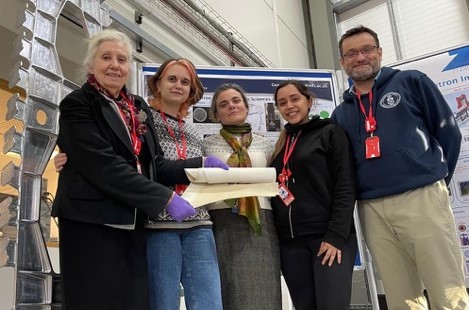 Did you know that normal paper nowadays lasts roughly 50 years (or more depending on paper quality), but parchment made by our ancestors can last over 3000 years, depending on storage conditions? This means we still have ancient documents for historical reference and education. However, keeping these documents from degradation so they last for future generations is what conservators continually try to achieve.
Did you know that normal paper nowadays lasts roughly 50 years (or more depending on paper quality), but parchment made by our ancestors can last over 3000 years, depending on storage conditions? This means we still have ancient documents for historical reference and education. However, keeping these documents from degradation so they last for future generations is what conservators continually try to achieve.
Researchers from the University of Toronto, Birkbeck University of London, and ISIS recently studied historical artworks and documents. The University of Toronto group travelled across the globe to use our non-destructive neutron scattering techniques at ISIS. When asked why they didn't use somewhere closer, Professor Laurent Bozec from Toronto replied, “We have built up a scientific relationship with Dr Genoveva Burca (who was an instrument scientist on IMAT), so we know our experiment will be in safe hands with her here at ISIS."
There were two studies between them, one based on strengthening parchment and the other on reinforcing and protecting painting canvases from further degradation. As these conservation procedures are at an early stage in development, they wanted to test how these approaches would affect their response to fluctuations in relative humidity (RH), as an increased response could ultimately lead to further damage making the treatment ineffectual. There have been cases throughout history where conservators have attempted to protect artworks from environmental factors and either irreversibly alter the artwork (in the case of laminating some Renaissance drawings) or use treatments that heighten the response to changes in relative humidity, resulting in further degradation. Thus, caution and rigorous testing are essential before novel conservation procedures can be used on artworks or documents.
Among the painting canvas samples tested were pieces from the linings removed during conservation treatment from 19th century Turner, Salvator Rosa and Landseer paintings. Samples were kindly provided by Cecil Krarup Anderson and Mikkel Scharff (The Royal Danish Academy – Architecture, Design, Conservation) and Stephen Hackney (Tate Conservation Dept). These pieces are rare, priceless samples, with their age meaning that they require protection from the environment around them.
Humidity fluctuations can change the structure of these materials. In paintings, these fluctuations alter the tension in the canvases, leading to potential cracking of the paint layers. In parchment, the fluctuations cause deformations such as wrinkling of the manuscript.
So, here at ISIS, the team could monitor their samples while imposing controlled relative humidity conditions in specially designed sample cell linked to a RH controller. Over a matter of hours, this simulated long-term exposure to potentially damaging high-humidity conditions. Some accelerated aged canvas samples were also tested to simulate 100s of years of aging, allowing them to see how the structure copes.
Professor Laurent Bozec, from the University of Toronto, described how their novel conservation technique is intended to directly reflect nature “We want to consolidate from the same material as is already in the sample. There is no use in patching things up with, for example, superglue as it will age at a completely different rate." So as parchment is made from organic material, they want to use organic material to fix it. Specifically, they looked at the protein collagen, used in many organisms as structural building blocks. Between each long strand of collagen are chemical bonds called crosslinks that hold them together in a strong structure. These crosslinks are essential to maintain the integrity of our bones, skin, and cartilage. Yet these are also found in parchments as parchment is made from animal hides. Over time, these crosslinks in parchment are under assault due to environmental conditions. “With our new approach, we can re-engineer these crosslinks in parchments."
Dr Marianne Odlyha, Senior Lecturer at Birkbeck, University of London, tested the effect of nanocellulose and alkaline nanoparticle-based treatments (which were similarly inspired by natural sources), on modern aged and historical canvas samples, including Turner and Landseer canvases. Nanocellulose is derived from natural sources and is chemically similar to the canvases. Calcium carbonate nanoparticles were also seen as a potential for future treatment, as calcium carbonate is often used in the original ground layers of a painting. The nanoparticles would not only act as a protective layer but could also act as an acidity buffer. There could also be potential in the future for collaborating with the Diamond Light Source, using X-ray methods to view whether the treatments would affect the crystallinity of the canvas structure.
Dr Genoveva Burca, Principal Scientist at Diamond Light Source and visiting scientist at ISIS, who implemented the biophysics research program on IMAT, encouraged this international collaboration and worked intensively together with the other members of the research team to get the best outputs and push the boundaries in this research field using the advanced technology available at ISIS.
With exciting prospects ahead, we look forward to hearing about the results of this experiment!
